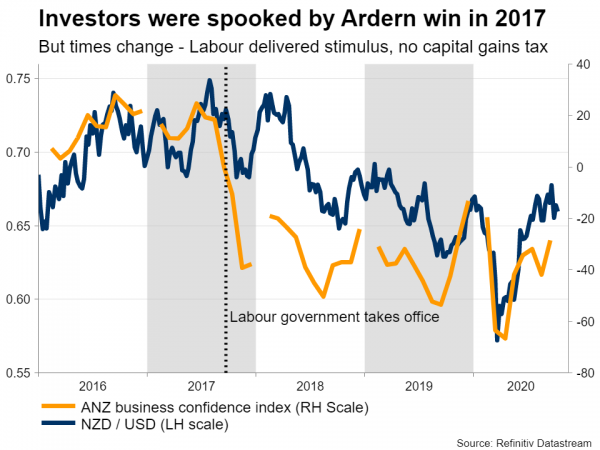New Zealand’s election takes place on Saturday and opinion polls suggest a decisive victory for incumbent Prime Minister Jacinda Ardern, who has become tremendously popular after successfully handling the healthcare crisis. The real question for the kiwi dollar is whether Ardern will win an outright governing majority, in which case the currency could get a small boost, or whether she will need a coalition with a smaller party. In the bigger picture, the primary drivers for the kiwi will be the global risk mood and how the US election plays out.
A relatively ‘safe’ election
Electoral surprises have been the name of the game in recent years, with the 2016 US election, Brexit, and more recently the Australian election upset of 2019. It is therefore reasonable that many people no longer trust opinion polls, but New Zealand’s upcoming election seems rather safe in this regard, as the lead that PM Ardern’s Labour Party holds is enormous.
Most polls have Labour leading the National Party by 10-15 percentage points, reflecting how popular the Prime Minister’s response was to the covid crisis, both on healthcare and economically. She enacted one of the earliest and tightest lockdowns globally, did not open New Zealand’s borders once the country eradicated the virus, and delivered powerful stimulus to keep the economy afloat.
Given the immense polling lead, the main element for markets might be whether Labour wins an outright governing majority in the lower house of Parliament, or whether PM Ardern will need the support of the smaller Green party again, which is currently propping up her government. The polls are very close on this matter, and it may come down to a hair.
How would markets react?
Admittedly, the kiwi fell in 2017 when Ardern was first elected, but times change. Her Labour party has delivered substantial stimulus, did not introduce a capital gains tax as many feared, and even ran a government surplus in 2018, paying down the nation’s debt.

Hence, while markets initially panicked about the prospect of left-wing policies, the actual fiscal management of the country was quite prudent. The implication is that an outright victory by Ardern this time may be viewed as a positive for the kiwi, albeit not massively.
In this case, the kiwi dollar could open with a gap higher on Monday to challenge the 0.6600 handle, where an upside break may open the door for a test of 0.6625.
But the real driver will be the global risk mood
Overall, this election is likely to be just a blip for the kiwi, not a game-changer. Monetary policy is also out of the spotlight, as the RBNZ has already telegraphed that it will cut rates early next year, and markets have priced that in. A quarter-point rate cut is fully factored in by April, and another by August.
So what will drive the kiwi? Most probably, how global risk sentiment changes and how the US election unfolds. New Zealand is an open, export-heavy economy, so the kiwi is very sensitive to global developments and risk appetite. Hence, in the immediate term, the main variable could be whether the latest correction in the stock market continues or abates.
A few weeks later, it will all be about the US election. If Joe Biden wins a decisive victory, that could fuel expectations for a massive stimulus package and for calmer US-China relations, both positive for the kiwi. On the flipside, if Trump wins or Congress stays divided, the opposite might occur.
At this stage, it looks like Biden will win the White House, but the Senate is too close to call, keeping the risk of a divided Congress on the table. If incoming opinion polls over the next weeks suggest this is an increasingly likely scenario, the uncertainty could weigh on the kiwi.
In this case, kiwi/dollar could edge lower to challenge the 0.6545 area, with a downside break turning the focus to 0.6510.













